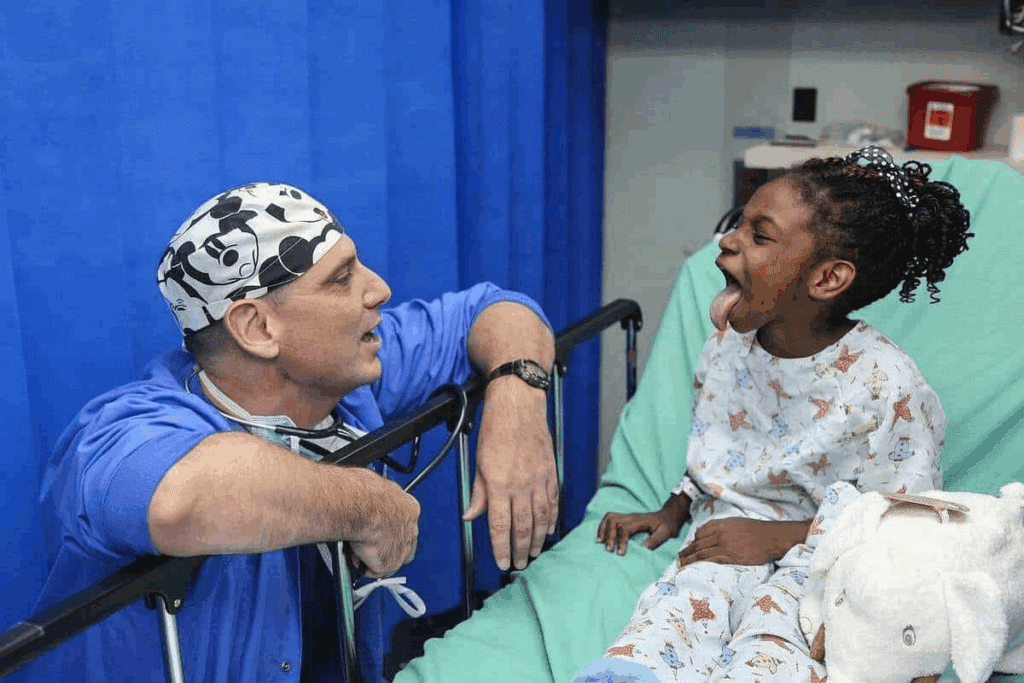Last Updated on November 20, 2025 by Ugurkan Demir

As a parent, it’s important to know about childhood cancer. Leukemia is the most common cancer in kids. At Liv Hospital, we offer trusted care that puts patients first.
We’ll share key facts about pediatric leukemia. You’ll learn about its types, symptoms, how it’s diagnosed, treated, and survival rates. We aim to help you and your family during this tough time.

Parents need to know about leukemia. This blood cancer happens when the bone marrow makes too many bad white blood cells. These cells take over, making it hard for the body to fight off infections.
To understand leukemia, we must look at its causes and how it affects kids.
We don’t know everything about why kids get leukemia. But we know some genetic and environmental factors might play a part. Genetic predisposition is a big factor, with some genes making kids more likely to get it.
Being around high levels of radiation and some chemicals can also raise the risk. But most kids with leukemia don’t have a clear cause.
Leukemia starts with a mutation in bone marrow cells. This mutation makes bad white blood cells. These cells build up in the bone marrow, stopping normal blood cells from being made.
In short, while we’re not sure of all the causes of leukemia in kids, knowing some factors can help parents. It’s about being aware of the risks and symptoms.

Knowing how common leukemia is in kids is key for parents and doctors. It’s the top cancer in children. This info helps shape healthcare plans and raises awareness among families.
Leukemia is a big part of childhood cancers. Looking at the numbers, we see it’s common and affects different groups in different ways.
Leukemia causes about 28% of all cancers in kids. It’s the leading cancer in children. This shows we need more research into why it happens and how to treat it.
A top pediatric oncologist says, “The high rate of leukemia in kids shows how critical early detection and treatment are.”
“Early diagnosis and treatment of leukemia can significantly improve outcomes for children.”
The world sees about 2.92 cases of leukemia in kids for every 100,000. This number changes based on where you are and who you are. It’s influenced by genetics, environment, and money status.
| Region | Incidence Rate per 100,000 |
| North America | 3.4 |
| Europe | 3.1 |
| Global Average | 2.92 |
Some groups face a higher risk of getting leukemia. This includes kids with certain genetic conditions, those exposed to a lot of radiation, and those from lower-income backgrounds.
Key Risk Factors:
Knowing these risk factors helps us create better plans to help kids with leukemia.
Parents need to know about the different types of leukemia in kids. This knowledge helps them understand their child’s diagnosis and treatment. Leukemia in children is divided based on the blood cell type affected and how fast the disease grows.
Acute Lymphoblastic Leukemia (ALL) is the most common leukemia in kids, making up about 75% of cases. It’s caused by the fast growth of immature lymphocytes, a type of white blood cell. Early diagnosis and treatment are critical for managing ALL well.
Acute Myeloid Leukemia (AML) is another common leukemia in kids, though less common than ALL. AML is caused by the fast growth of abnormal myeloid cells, which fight infections. Treatment for AML often involves intensive chemotherapy and, in some cases, bone marrow transplantation.
While acute leukemias are more common, chronic leukemias can also occur in kids, though rarely. Chronic Lymphocytic Leukemia (CLL) and Chronic Myeloid Leukemia (CML) are usually seen in adults but can happen in children. Other rare leukemia types may also occur, needing special treatments.
| Type of Leukemia | Characteristics | Prevalence in Children |
| Acute Lymphoblastic Leukemia (ALL) | Rapid production of immature lymphocytes | 75% of childhood leukemia cases |
| Acute Myeloid Leukemia (AML) | Rapid growth of abnormal myeloid cells | Less common than ALL |
| Chronic Lymphocytic Leukemia (CLL) | Slow progression, typically in adults | Rare in children |
| Chronic Myeloid Leukemia (CML) | Slow progression, often associated with a specific genetic abnormality | Rare in children |
Knowing the specific type of leukemia is key to finding the right treatment. By understanding each type, parents can better support their child through diagnosis and treatment.
Leukemia in children is influenced by age. It’s a cancer of the blood and bone marrow. It’s the most common childhood cancer, affecting different age groups differently.
Infants under one year face the highest risk of leukemia. This includes Acute Lymphoblastic Leukemia (ALL) and Acute Myeloid Leukemia (AML). Their leukemia often has unique genetic traits and may have more treatment complications.
The MLL gene is often involved in infant leukemia. This can make the disease more aggressive and harder to treat. Studies show that infants with MLL-rearranged ALL need special treatment plans.
Leukemia is a big concern for toddlers and school-age children. ALL is the most common type in this age group. Symptoms include fatigue, pale skin, and frequent infections.
Thanks to better treatment plans, survival rates have improved. Toddlers and school-age children with leukemia get intensive chemotherapy. This can affect their health and development. It’s important to monitor and support them during and after treatment.
Adolescents with leukemia face special challenges. The disease and its treatment can affect their physical and emotional development. Treatment plans for adolescents may be different, as they can handle more intense treatments.
Adolescents and young adults with leukemia often join clinical trials. This gives them access to new treatments and helps advance leukemia care.
| Age Group | Common Types of Leukemia | Key Considerations |
| Infants (<1 year) | ALL, AML | MLL gene rearrangements, aggressive disease |
| Toddlers and School-age Children | ALL | Intensive chemotherapy, long-term effects |
| Adolescents | ALL, AML | Unique treatment considerations, clinical trials |
Understanding leukemia in children by age is key to better care. It helps tailor treatments for each age group. This way, healthcare providers can improve outcomes and support young patients’ well-being.
Children with leukemia might show several physical signs. These include:
Remember, these signs can also mean other illnesses. But if your child has many of these symptoms at once, see your pediatrician.
Leukemia can also lead to behavioral changes in kids. These might be:
These changes might be small, but if they last or are serious, they need to be looked into.
If your child shows any of these signs, call your pediatrician right away:
Spotting leukemia early and treating it can greatly help kids. As a parent, watching your child’s health closely is very important.
Diagnosing leukemia in children takes several important steps. As parents, knowing this process can ease some of the worry and fear. We’ll walk you through from the first blood tests to confirming the diagnosis.
The first step is a detailed medical check-up and blood tests. These tests look for blood abnormalities that might show leukemia. Complete Blood Count (CBC) is a key test that checks blood cell levels. “Abnormal CBC results can signal early.” Doctors also do physical exams to look for signs like swollen lymph nodes or unusual bruising. These findings guide the next steps in diagnosis.
If tests hint at leukemia, a bone marrow biopsy follows. This involves taking a bone marrow sample for examination. It’s a key test for diagnosing leukemia and figuring out its type. Tests like molecular and genetic testing also help understand the leukemia’s details.
These tests reveal specific genetic changes or mutations in the leukemia cells. This info is key for creating a treatment plan that fits your child’s needs.
“Diagnosing leukemia is more than just finding cancer; it’s about knowing the disease’s unique traits in each child,”
Understanding Your Child’s Specific Diagnosis
After confirming the diagnosis, knowing the leukemia type and its details is vital. Your healthcare team will go over the test results. They’ll explain the leukemia type, stage, and any genetic features.
Parents need to ask questions and get clear on any parts of the diagnosis they don’t understand. Being informed helps in making treatment decisions and knowing what to expect.
Getting a leukemia diagnosis is tough, but with the right info and support, parents can face this journey with more confidence.
Children with leukemia get treatment that combines old and new methods. It’s important to know the different ways to treat this disease.
Leukemia treatment in kids has several phases. Each phase has its own goals and challenges. The main treatments are:
These treatments are often mixed. They are chosen based on the child’s diagnosis and how they react to treatment.
New research has brought innovative treatments for kids with leukemia. Some of these include:
These new treatments give hope to kids with leukemia and their families.
It’s key to manage leukemia treatment side effects for kids’ quality of life. Common side effects are:
We help families find ways to deal with these side effects. This includes medicine, nutrition, and other support.
Children with leukemia now have a much better chance of survival. In countries with good healthcare, over 85% of kids beat the disease. This big jump is thanks to years of research and better ways to treat the illness.
The 5-year survival rate for kids with leukemia is a big win for medicine. In places with top-notch healthcare, this rate is over 85%. This is a huge leap from what it used to be.
Many things can change how well a child with leukemia will do. The type of leukemia, the child’s age, and how well they respond to treatment are key. Knowing these helps doctors plan the best treatment.
Even with the good news, there are big differences in survival rates around the world. These differences come from things like access to healthcare and money. They also depend on where you live and how much money your family has.
| Region | 5-Year Survival Rate |
| Developed Countries | >85% |
| Developing Countries | 50-70% |
To fix these differences, we need to work on healthcare worldwide. We must make sure everyone has access to the best treatments. We also need to keep researching for even better, more affordable ways to fight leukemia.
When a family gets a leukemia diagnosis, it’s a tough time. We stress the need for full support for kids with leukemia and their families. This support must cover their medical, emotional, and mental health needs.
Supporting kids with leukemia is key during this hard time. Families need help finding resources, getting advice, and receiving care. This way, they can deal with the diagnosis and treatment better. With the right support, families can feel stronger and not so alone.
We aim to give top-notch healthcare and support to families worldwide. Our goal is to make sure families get the care and support they need. This way, they can successfully go through the leukemia journey.
Together, we can really help kids with leukemia and their families. We’re committed to giving them the support and resources they need. This will help them face the challenges ahead.
Childhood leukemia is a cancer that affects the blood and bone marrow. It happens when white blood cells are made abnormally. It’s the most common cancer in kids, with Acute Lymphoblastic Leukemia (ALL) being the most common type, making up about 75% of cases.
Kids with leukemia might feel very tired, have pale skin, or get sick often. They might also bruise easily or have swollen lymph nodes. Changes in behavior, like not wanting to eat or being very irritable, can also be signs.
Doctors use several tests to diagnose leukemia. First, they do blood tests to see if there are abnormal cells. Then, a bone marrow biopsy confirms if leukemia cells are present. Tests like genetic analysis help find out the exact type and characteristics of the leukemia.
Treatment for kids with leukemia usually includes chemotherapy. Sometimes, they might also get targeted therapy, radiation therapy, or a bone marrow transplant. The treatment plan depends on the type of leukemia, its characteristics, and the child’s health.
The outlook for kids with leukemia has gotten much better. In developed countries, the 5-year survival rate is over 85%. The type of leukemia, how well the child responds to treatment, and genetic markers all play a role in the prognosis.
Leukemia can happen in kids of all ages. But babies under one year are at the highest risk. Toddlers, school-age kids, and teenagers are also affected. Each age group has its own challenges and treatment considerations.
Yes, there are differences in leukemia outcomes around the world. These differences are due to things like access to healthcare, treatment options, and socioeconomic factors. This affects survival rates and the quality of care.
Families get a lot of support, including emotional help and guidance on treatment. They also get access to resources for managing care. Healthcare providers are key in providing support and connecting families with services.
Right now, there’s no way to prevent most childhood leukemia. But knowing the risk factors and recognizing symptoms early can help with diagnosis and treatment. This can improve outcomes.
The long-term effects of leukemia treatment vary. They depend on the treatment and the child’s health. Possible effects include growth and developmental issues, a higher risk of secondary cancers, and organ problems. Ongoing care is important to manage these effects.
PubMed Central. (2023). Childhood leukemia: Epidemiology, survival trends, and treatment advances. Retrieved October 20, 2025, from https://www.ncbi.nlm.nih.gov/pmc/articles/PMC9456789/
Subscribe to our e-newsletter to stay informed about the latest innovations in the world of health and exclusive offers!